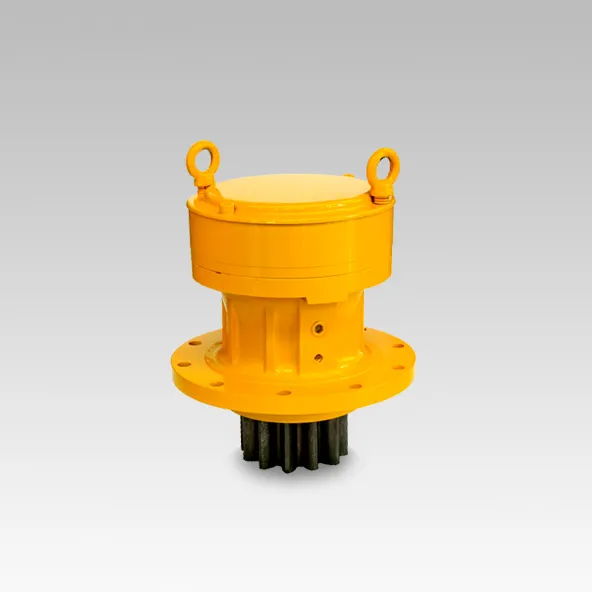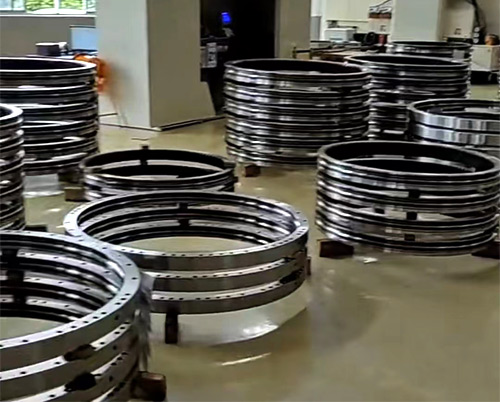
Το swing mechanism of an excavator is a crucial component that enables the machine to rotate on its axis, allowing the operator to perform various tasks with ease and precision. This mechanism is essential for the efficient operation of an excavator, as it provides the machine with the necessary flexibility and maneuverability to work in tight spaces and navigate complex terrain. In this article, we will delve into the intricacies of the swing mechanism, exploring its various components and the role they play in the overall functionality of an excavator.
The swing mechanism of an excavator is primarily composed of two main components: the slewing ring and the slewing bearing. The slewing ring is a large, circular component that is mounted on the excavator’s mainframe, and it serves as the pivot point for the machine’s rotation. The slewing bearing, on the other hand, is a complex assembly of bearings and seals that facilitate the smooth rotation of the slewing ring.
The slewing ring is designed to withstand the immense forces generated during the excavator’s operation, as it must support the weight of the machine and its attachments while allowing for a full 360-degree rotation. This is achieved through the use of high-strength materials and advanced manufacturing techniques, which ensure that the slewing ring is both durable and reliable.
The slewing bearing, meanwhile, is responsible for minimizing friction and wear between the slewing ring and the excavator’s mainframe. This is crucial for maintaining the smooth operation of the swing mechanism, as excessive friction can lead to reduced performance and increased wear on the components. The slewing bearing is typically composed of a series of rollers or balls that are housed within a sealed enclosure, which helps to protect them from dirt and debris while also providing a stable environment for their operation.
In addition to the slewing ring and slewing bearing, the swing mechanism also relies on a number of other components to function properly. These include the slew motor, which is responsible for driving the rotation of the slewing ring, and the slew brake, which is used to hold the machine in place when necessary. The slew motor is typically an electric motor, although some excavators may use hydraulic motors instead. The slew brake, on the other hand, is typically a hydraulic device that uses pressure to apply a braking force to the slewing ring, thereby holding the excavator in place.
The swing mechanism of an excavator is a complex and intricate system that requires careful design and precise manufacturing to ensure its proper operation. By understanding the various components and their roles within the swing mechanism, operators can better appreciate the importance of this critical system and take steps to maintain and care for it properly. This will not only help to extend the life of the excavator but also ensure that it continues to perform at its best, providing the operator with the flexibility and maneuverability they need to complete their tasks efficiently and effectively.
The swing mechanism of an excavator is a crucial component that allows the machine to rotate and perform various tasks efficiently. This mechanism is responsible for the smooth operation of the excavator’s boom and arm, enabling them to move in a circular motion. In this article, we will explore the swing mechanism in detail, focusing on its role in excavator stability and the importance of counterweights.
The swing mechanism of an excavator is designed to provide the machine with the ability to rotate 360 degrees, which is essential for efficient operation in tight spaces or when performing tasks that require precise movement. This mechanism is typically powered by a hydraulic motor, which is connected to the excavator’s undercarriage. The hydraulic motor drives a pinion gear, which in turn engages with a larger ring gear mounted on the excavator’s frame. This engagement causes the excavator’s superstructure, including the cab, boom, and arm, to rotate around the undercarriage.
One of the key factors that contribute to the stability of an excavator is the counterweight system. Counterweights are heavy, cast iron or steel components that are strategically placed on the excavator to balance the weight of the superstructure. These weights are essential for maintaining stability during operation, as they help to counteract the forces generated by the swing mechanism.
The counterweight system plays a vital role in ensuring that the excavator remains stable and does not tip over during operation. By distributing the weight evenly across the machine, the counterweights help to maintain a low center of gravity, which is crucial for maintaining stability during rotation. Additionally, the counterweights also help to absorb and dissipate the forces generated by the swing mechanism, reducing the stress on the machine’s components and improving overall performance.
In some excavator models, the counterweights are fixed and permanently attached to the machine. However, in other models, the counterweights can be removed or adjusted to suit specific job requirements. This flexibility allows operators to customize the excavator’s stability based on the tasks they are performing, ensuring that the machine remains stable and safe to operate at all times.
Another important aspect of the swing mechanism is the lubrication system. This system is responsible for supplying the necessary lubrication to the various components of the swing mechanism, such as the hydraulic motor, pinion gear, and ring gear. Proper lubrication is essential for maintaining the smooth operation of the swing mechanism and preventing premature wear and tear on the components.
In conclusion, the swing mechanism of an excavator is a critical component that enables the machine to rotate and perform tasks efficiently. The counterweight system plays a vital role in maintaining the stability of the excavator during operation, while the lubrication system ensures that the swing mechanism operates smoothly and efficiently. By understanding the importance of these components and their role in excavator stability, operators can ensure that their machines remain safe and effective tools for a wide range of tasks.
The swing mechanism of an excavator is a crucial component that allows the machine to rotate on its axis, enabling the operator to perform tasks with precision and efficiency. This mechanism has undergone significant advancements over the years, transforming the way excavators operate and contributing to their widespread use in various industries. In this article, we will delve into the history of excavator swing mechanisms, their current state, and the potential future developments that could further enhance their performance.
In the early days of excavator development, the swing mechanism was relatively simple, consisting of a universal joint that connected the machine’s undercarriage to its superstructure. This design allowed for limited rotation, but it was not very efficient and lacked the precision required for complex tasks. As technology advanced, so did the swing mechanism, with the introduction of the swing boom in the 1960s. This innovation allowed for a more fluid rotation, enabling the excavator to perform tasks with greater accuracy and speed.
The 1970s saw the emergence of the swing drive mechanism, which significantly improved the excavator’s maneuverability. This system utilized a hydraulic motor mounted on the undercarriage, which drove a pinion gear connected to the superstructure. This allowed for smooth and continuous rotation, making it easier for operators to carry out tasks such as digging, grading, and loading.
The 1980s brought about further advancements in swing mechanisms, with the development of the slew drive system. This design replaced the universal joint with a series of gears and bearings, providing a more stable and precise rotation. The slew drive system also allowed for greater torque, enabling the excavator to handle heavier loads and perform more demanding tasks.
Today, the swing mechanism of an excavator is more advanced than ever, with manufacturers continually striving to improve performance and efficiency. One notable development is the use of electronic control systems, which allow for more precise control of the excavator’s rotation. These systems can also monitor various parameters, such as temperature and pressure, to ensure optimal performance and prevent potential issues.
Looking to the future, we can expect further advancements in excavator swing mechanisms that will continue to enhance their performance and capabilities. One potential development is the integration of artificial intelligence (AI) into the control systems, allowing for even more precise and efficient operation. AI could also enable excavators to learn from their operators, adapting their performance to suit specific tasks and conditions.
Another area of potential growth is the use of alternative power sources, such as electric and hybrid systems. These technologies could provide a more sustainable and environmentally friendly solution for excavator operation, while also offering improved performance and reduced operating costs.
In conclusion, the swing mechanism of an excavator has come a long way since its early beginnings, with each advancement contributing to the machine’s increased efficiency and versatility. As technology continues to evolve, we can expect further improvements in excavator swing mechanisms that will enable these machines to perform even more complex tasks with greater precision and ease.
The swing mechanism of an excavator is a crucial component that allows the machine to rotate its superstructure, or the cab and arm assembly, around a pivot point. This rotation enables the excavator to move in a full circle, increasing its versatility and efficiency in various tasks such as digging, grading, and loading materials. The swing mechanism typically consists of a slewing ring, bearings, and a hydraulic motor, which work together to facilitate smooth and precise rotation of the superstructure.
